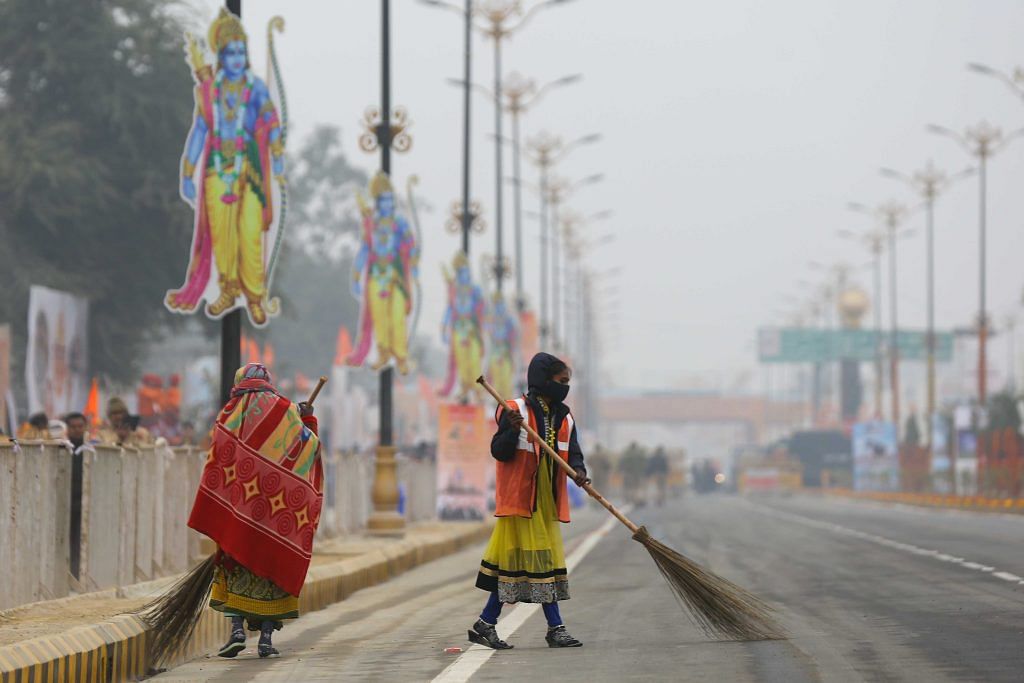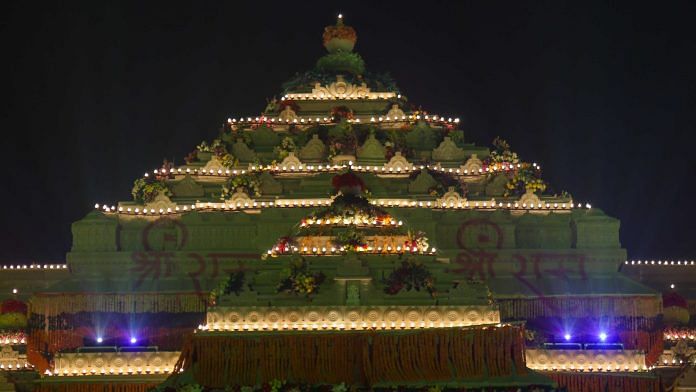Praveen Jain still marvels at what he beheld: “It’s a miracle.” For Neelam Pandey, it was like a “film set”, while Sagrika Kissu was surprised to discover how different Ayodhya was: “I thought it would be a cramped, dirty city.” Instead, she found a modern, coming of age pilgrimage destination.
Which is why, in one of her early stories, she would write, “This is Ayodhya reimagined, rebooted, and rebuilt as a modern-day 21st-century temple town with wide roads, orange houses, multi-level parking, Wi-Fi hotspots, lakefront cafes, an international airport, electric buses, luxury hotels, homestays, and 3D sound and light shows.”
So modern that the first hotel she stayed in had a swimming pool and somewhere down by the Saryu river, revellers ate fresh fish fry – “One of the things I liked best about this assignment,” said Kissu with a laugh.
Jain, ThePrint’s National Photo Editor, was in Ayodhya when the Babri Masjid was demolished in 1992 and has been a frequent visitor over decades. “It was just a small, ramshackle town then; now, it has totally changed.”
“Picture perfect,” added Pandey, Associate Editor, who was last there in 2019 after the Supreme Court verdict allowed Hindus to build a temple on the site of the razed mosque. “Then it was a small, quaint town…”
That’s how I remember it, too: in the early 1990s, I had travelled to Ayodhya, by road, to write about the ongoing mandir agitation, for The Indian Express. All that I recall is a very bumpy ride to a town clouded in dust, and heavy security arrangements everywhere.
This transformation of Ayodhya, from an edifice of the past to a bright new township, became the focus of ThePrint’s two-month coverage of the city, which was preparing to ‘welcome’ Ram Lalla on 22 January 2024.
Through countless ground reports, news stories, on-the-spot videos and evocative photographs, ThePrint has offered readers a brick-by-brick reconstruction of a city that has been built, virtually, out of thin air. In the past few days, I have read or watched approximately 100 reports, opinion pieces, interviews, book extracts about Ayodhya at ThePrint—this is besides the regular news stories and agency updates.
I did this while watching television news coverage of the build-up to the ceremony and reading four daily newspapers. It’s fair to say, ThePrint’s coverage was ahead of most other media; it was substantial and substantive. It painted a vivid picture of a city teeming with life—reinvented and rejuvenated.
For 22 January, five journalists of ThePrint were in Ayodhya, several days in advance. That indicates the significance of the consecration and how seriously ThePrint took it. If this was the first draft of history in the making, we wanted to be sure we wrote it.

Also read: Manipur clashes coverage was ThePrint’s most important journalism in 2023
Ayodhya, people, temple—beyond the politics
ThePrint was an early bird, swooping in and out of Ayodhya from early December, to bring you, the reader, whatever it could pick up from the ground. “Ayodhya and the Ram temple isn’t just the most significant political story of the year. It is potentially an era-defining shift in India’s cultural politics. So it wasn’t enough to cover it from just the prism of party politics. I wanted my Ground Reports team to be in on it early,” said Rama Lakshmi, Editor, Opinion and Ground Reports.
The coverage fell into three broad categories—the raising of Ayodhya, the politics of the mandir, and the pran pratishtha ceremony.
While most of us have a working knowledge of the mandir-masjid political angle, curiosity was aroused by the city itself. Nisheeth Upadhyay, Editor, News Operations, said the focus of ThePrint’s coverage was “a new city coming up within the old one”. “Politics or the significance of the event was there, but we wanted to delve into the culture and subcultures around a modern temple town,” he said.
And so, Ayodhya it was.
Sagrika Kissu, Principal Correspondent, first travelled to Ayodhya on 30 November. She said the brief to her was, “go see what’s happening…”
Plenty, as it happened, was happening. From the first week of December, she began to file stories on the various changes and developments projects—a police force trifurcated to create a ‘tourist police’, a tent city for visitors with LED screens, ACs, sofas in each room, and 2,000 spanking new public toilets, widening of roads, and murals of Ram everywhere alongside Coca Cola hoardings. Shops with religious symbols and every wall or building painted saffron: “If Jaipur was the pink city, Ayodhya was the saffron city,” said Kissu.
She talked to city planners, architects, hung out at the VHP Karsevakpuram, met government officers and artisans from across India – people behind the renovation of the city. Here is a sample of her stories:
Tent cities for 1 lakh visitors to 2,000 public toilets — Ayodhya prepares for Ram temple opening
Ayodhya splits police stations, sets up help centres as prep for Ram temple opening picks up pace
Ayodhya is being rebooted, rebuilt, & reimagined—Gen Z pilgrims, luxury hotels, 3D shows
Only VVIPs allowed? Ayodhya hotels say scrambling to cancel bookings ahead of Ram temple opening
Food plaza, escalators, AC retiring room — revamped Ayodhya railway station all set for inauguration
Ram temple workers pull double shifts to meet consecration deadline — ‘it’s God’s work’
Meet the crack team behind Ayodhya’s transformation into modern temple town
Among others, this one caught my eye: whatever happened to the women in Ayodhya – the Durga Vahinis?
Besides Kissu, other correspondents wrote on different aspects: Shikha Salaria, Special Correspondent, wrote an interesting story about the Suryavanshi Thakurs who claim their ancestors “fought the Mughals for Ram Janmabhoomi”.
Salaria’s interview of Iqbal Ansari, one of the litigants in the Ayodhya case and the son of original litigant Hashim Ansari, pointed to a new approach by Muslims to this temple town and the erasure of any mention of 1992.
Correspondents Nootan Sharma and Krishan Murari offered a rare insight into the ‘tryst with politics’ and influence of the four Shankaracharyas who decided against attending the 22 January event.
From Agra, Journalist Amir Qureshi wrote of a village in the nearby ravines where an ashram is said to be the “home to the sage Shringi, who was married to Ram’s sister Shanta.”
There were reports on the innovative security arrangements for the 22 January consecration like the one from Kissu (with photographs from Manisha Mondal) about the neighbourhood houses with a direct view of the temple premises being on the radar of security officers. Another report by Principal Correspondent Bismee Taskin told us about Ram Lalla’s own “dedicated gunner” and the priest with the sole access to the idol.
I don’t know about you, but I found much of this fascinating. More importantly, much of it was news to me and, I suspect, to many readers.
Also read: Lights, camera, storytelling—how ThePrint photojournalists tell news and win awards
A ‘new’ city caught in 3 photojournalists’ lens
The written words were enhanced by the photographs and videos by Praveen Jain’s team of photojournalists Manisha Mondal and Suraj Singh Bisht. As they trudged down the old-new streets, the three managed to convey the symbolism, the sights and even the sounds. In Praveen Jain’s photographs of dogs being rounded up before the consecration, you can hear the helpless yelps of a dog in the net. “I heard the dog howling and I rushed,” said Jain.
Mondal’s panoramic look at the city and temple under construction displays its majesty.
Ram’s name on shops & souvenirs, old jostling with new — glimpses from Ayodhya, a city being rebuilt
While a Suraj Bisht video-photographic essay shows the hectic preparations of a city on the move.
Deity, VIPs & devotion — snapshots of Ayodhya in throes of Ram temple fervour
And, Jain’s photographs of Ram and Prime Minister Narendra Modi’s cut outs/hoardings on every pole or streetlight highlighted the fusion of religion with politics.
Inside Ayodhya as pran pratishtha draws near: Street art, selfie points and army of devotees
“I think we did a good job,” he said. “We have learnt that in online journalism, you have to react immediately; every moment is important.”
By the time 22 January came along, readers had a pretty good idea of what to expect. Correspondents Neelam Pandey and Sagrika Kissu filed reports and videos on the last-minute preparations, the look and feel of the city, and how the public felt about the pran pratishtha, what residents say about the makeover as well as this unusual one about compostable prasad plates.
“The feeling I came away with was that the people wanted to reclaim what they saw as rightfully theirs,” said Pandey, adding that for them, the Ayodhya ceremony was not an end in itself. “It’s just the beginning.”
From ThePrint’s perspective, the decision to start its coverage from Ayodhya, in early December, was the correct one. “It received a lot of traction,” said Upadhyay. “The stories and the videos worked really well.”
Also read: How Mandir, Modi, & Media played their roles in Ayodhya for BJP ahead of Lok Sabha election
Opinions to complement the news reports
If Ayodhya rising was the talk of the town, mandir politics were never far behind. ThePrint faithfully reported on aspects like the Congress’ dilemma – to attend or not to attend – and eventual decline along with other Opposition leaders and the Shankaracharyas’ decision to skip the consecration ceremony. However, it was out of the box stories that worked best: Madhya Pradesh Congress’ bike rally to Ayodhya, BJP ‘mandir influencers’ in every constituency, and the ‘backlash’ in Ayodhya over the Ram Temple Trust’s “request” to LK Advani and Murli Manohar Joshi to not attend the ceremony are few.
If the ground reporting, audio-visual stories/interviews, and the political reporting gave us an understanding of the immediate events and developments in Ayodhya, then the Opinion section gave it context. From Kapil Komireddi on Congress’ redemption to Sheela Bhatt on how Congress “blew” it, there was plenty to think about. Professor Patrick Olivelle, in a ‘timely’ article—but without mentioning Ayodhya or the Ram temple—wrote about when large Hindu temples came into being, as part of his series ThePrint Purana.
There were interesting points of view from Muslim scholars Ibn Khaldun Bharati (a pseudonym) and TV news panelist Amana Begam, suggesting how the community would benefit from moving on.
“And the Ayodhya story isn’t over,” said Rama Lakshmi. Just a few days ago, Vandana Menon, Assistant Editor, travelled on the Ayodhya Express with passengers on their way to pay homage. One fellow traveller was 82-year-old Latadevi. “I feel like I saw heaven for a moment,” Latadevi told Menon who described how Ayodhya and the Ram temple are now “part pilgrimage, part tourism, part endurance sport for Latadevi, her son and thousands like them.”
For Sagrika Kissu this was one of her best reporting assignments, not least because she has a better understanding of the country and its people. “People have emotions connected to God. I understood that it is a deeply religious country and a political country.”
Shailaja Bajpai is ThePrint’s Readers’ Editor. Please write in with your views, complaints to readers.editor@theprint.in
(Edited by Prashant)



